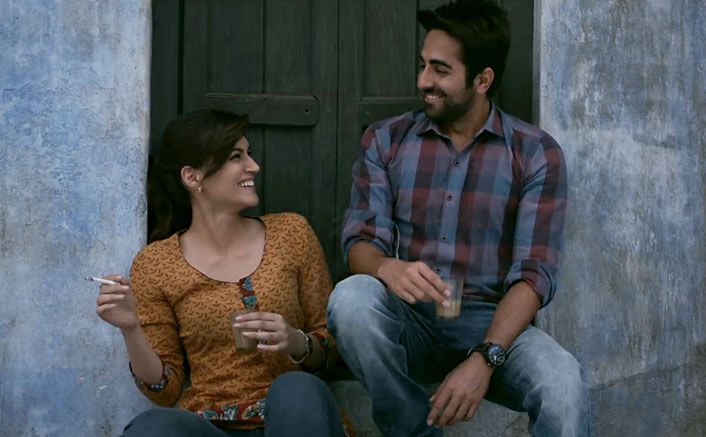Bareilly Ki Barfi: An Analysis
- Sukhmani Malhi

- Jul 4, 2019
- 7 min read

Set in the small town of Bareilly in Uttar Pradesh, Ashwini Iyer Tiwari’s Bareilly Ki Barfi is the riveting story of a young girl named Bitti Mishra, who is brought to life effortlessly by Kriti Sanon, in her portrayal of one of the most well written female characters in a Bollywood film, as far as the mind can recall. Bitti is not plagued by her small-town middle class life, but content in it, finding joy in her independence and free-spiritedness, she smokes, drinks alcohol straight from the bottle and spends her time watching English movies with her best friend, translating them to the best of her abilities. She works at the complaints department of the local electricity supply board and has her reply learnt by heart. Bitti has a loving relationship with her eccentric parents, her father, the owner of a small sweet shop and her testy mother who wants Bitti to get married at the earliest. Bitti herself is not opposed to the idea but wants to find a husband who does not judge her for her antics and accepts her for who she is. Upon facing rejection in the marriage market and from society in general for smashing the stereotypical image of what a small town girl is supposed to be like, she decides to run away from home in an almost mockumentary style sequence at the railway station. It is here that she finds a small paperback titled “Bareilly Ki Barfi”, gathering dust on a small bookstall and the plot ensues. What sells the movie almost immediately as a favourite of both, the masses and the critics, is the lively screenplay with well-rounded, believable characters who are shaped to be immensely relatable owing to the unparalleled performances of a cast ensemble that includes names like Ayushmann Khurrana, Rajkumar Rao and veterans like Pankaj Tripathi and Seema Pahwa. The movie is a loose adaptation of The Ingredients of Love, by French author, Nicolas Barreau, transporting the age-old tale of secret love and a spin on the classic Cyrano De Bergerac. Upon reading the book, Bitti finds that the protagonist is a lot like her, she breakdances, smokes on the sly, and lives by her own rules. She is taken aback by the progressive thinking of the author and the loving way with which he writes about a character like Bitti, she is touched to know that someone could love her the way she is and not want to change anything about her. Meanwhile, the audience is introduced to Ayushmann Khuarrana’s charcter, that of charming printing press owner, Chirag Dubey, who prints wedding invitations by day and cries over his lost love with a bottle of whiskey at night. Bitti sets out to find the author of the novel that changed her life, whose name and picture is printed on the jacket as Pritam Vidrohi. The owner of the bookstall, Munna, who is also Chirag’s best friend, introduces them to each other, telling Bitti that he is the publisher of the book. Chirag tells Bitti that Pritam Vidrohi has left the city, not revealing he is the one who actually wrote the book, whose author Bitti has fallen in love with, after suffering a heartbreak. The two grow to become close friends, spending a lot of time together. Bitti writes letters to Pritam and asks Chirag to get them through to him. Chriag writes back to her as Pritam Vidrohi but when Bitti asks incessantly to meet the writer of book, Chirag and Munna set out to Lucknow to bring back the real Pritam Vidrohi played by Rajkumar Rao, so that he can meet Bitti. Chirag, having fallen for Bitti, coaches Pritam to be exactly the kind of the arrogant guy with a bad attitude that she would hate. Vidrohi, a salesman in a saree showroom who is perpetually anxious, extremely polite and an easily bullied, pushover does what he is asked to do, which is how he ended up on the back cover of the book in the first place. A quick makeover montage later, Pritam Vidrohi follows instructions and behaves rude and boorish to get Bitti to hate him but at the same time he displays his naturally sensitive side, causing Bitti to stick around. Bitti’s best friend Rama and Pritam start developing feelings towards each other, while Chirag is trying to get rid of Vidrohi and create distance between him and Bitti by spreading rumours about him being a divorcee. This is when Pritam goes through a real transformation, and decides to spite his bullies, Chirag and Munna for pushing him around. He convinces Bitti to get married to him and her parents who have already grown to like him. Chirag who threatened to reveal the truth to the love of his life about who they all had been betraying her the whole time, couldn’t bear to do so when he sees how happy she is on the day of her engagement. He realises how blinded he was by his selfishness and now knows that he is happy as long as Bitti is. He writes a final letter to her as Vidrohi and asks him to read it to her at the engagement ceremony. However, at the engagement Pritam has a sore throat and suggests that Chirag he read it to her himself. When he does so, he is overcome by emotions and so is everyone else, left in tears. That’s when Bitti reveals to Chirag that she had known the truth all along, revealed to her by Pritam Vidrohi in a spur of emotion. She tells him how everything was an act to test if Chirag actually loved her or if he was just in love with the version of his ex-girlfriend he saw in her. She reveals that she too is in love with him. Chirag apologizes to Vidrohi and the movie ends with Chirag and Bitti getting together. The film is filled small joys such as situational humour and chuckle some one-liners. Rajkumar Rao’s steals the show bringing the story to life with his entry as Pritam Vidrohi, a much loved character, whose transformation into a boorish rowdy guy, his accent and body language, all leaves the audience in splits. The vibrant, entertaining folksy music, colourful camerawork and thoughtful, consistent charcters are what make the movie work. The landscape and setting inspirited by the by-lanes of Ekta Nagar, Bareilly accurately capture the essence of small-town North India that the director wanted to and could well be considered another primary character in the movie. Character dynamics, especially the one between Bitti and her father, who raised her with all the freedom he’d give to a son, are extremely authentic. But despite her relatively non-interfering liberal parents, Bitti feels stifled by the kind of men she meets and the impending doom of getting married to a regressive, narrow-minded man. Prospective grooms ask her questions that would never be asked to a man, like if she’s a virgin. The novel that sets her free, Bareilly Ki Barfi, is a symbol of finding goodness in your own flaws when seeing yourself through the eyes of others. What sustains the liveliness of the film though, is its well-placed humour, wordplay and some well-timed moments such as the boat ride where a suicide spot is pointed out by the boatman, “Here lies the grave of 72 doomed lovers”. The story tends to be a tad bit predictable but it is the pace of the film that never wavers and the authenticity of the characters and set-up which makes sure there is no dull moment in the film. Garnering appreciation from both critics and audience, Bareilly Ki Barfi turned out to be a winner at the box office. It begins with a travelling overhead shot with the voice-of-god narration of Javed Akhtar that continues throughout, before zooming in on one particular household, where confectionary store owner Bitti’s father is asking his wife, Sushila where his cigarettes have gone. Busy with her prayers, she tells him to ask their daughter, exploding two minor taboos in one go. It turns out Bitti doesn’t have her father’s cigarettes, but borrows one so that he can get through his morning business. This opening sketches the pally father-daughter relationship and the casual “modernity" of Bitti’s home, at odds with the small town she’s in. A moment of victory for Bollywood films, this romantic comedy, introduces the audience to infectiously charming characters. It not only excels in writing, direction, acting and music departments but is a laugh riot. This is the story of a woman told by a woman. The strongest message that comes across is that girls, never mind which city they belong to, be it Bareilly or Bombay should live their lives the way they choose to. The female characters of the film are realistic and bold. It could almost be considered the director’s attempt at a subtle feminist statement. In The Ingredients of Love by Nicolar Barreau, in the midst of a breakup, the protagonist, Auriele Bredin, a Parisian restaurateur, stumbles across a novel in a small bookshop. Mysteriously, her restaurant and Auriele herself are featured in the book. She realizes that it has saved her life and attempts to contact the shy, attractive author through his French publishers. The rude, impolite chief editor of the publishing company reluctantly forwards Auriele’s letter to the author but she refuses to give up. One day she receives a response from the reclusive writer but the encounter that takes place between them is completely different from what she imagined. Set in the City of Light, Paris, the original novel revolves around the themes and symbols of the French culture, cuisine, language and books. Ingredients of Love resembles Chocolat, a 1999 novel by Joanne Harris, with its beautiful descriptions of French cuisine and actual recipes at the end of the book, offering insight into the French publishing world. While it is supposedly written by a male author, it is easy to tell that the writer is a woman. Nicolas Barreau is a pseudonym for a well-known German author, translator, publisher and literary editor figure widely speculated to be Daniela Thiele.







Comments